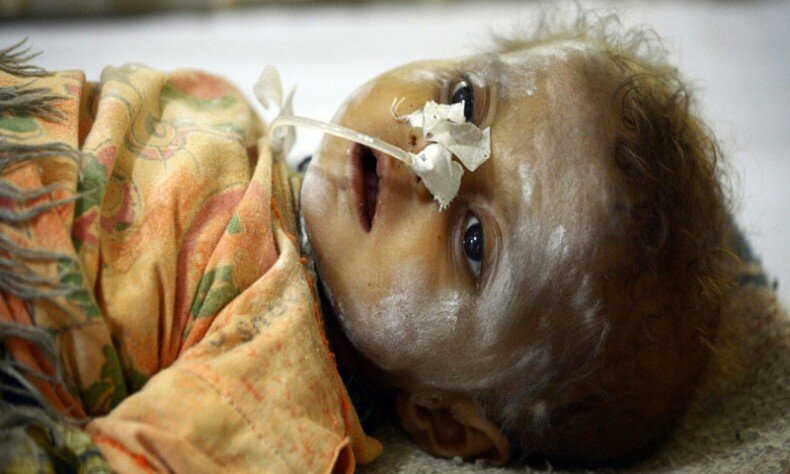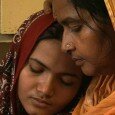By Amar Guriro –
Thanks to indifferent attitude of Sindh government the miseries of the dwellers of Thar are not ending and the children are the main casualty of poor governance
No one can feel the intensity of pain of a mother whose two year old son died two months ago and now her newly born daughter is also not feeling well. Lakshmi Menghwar, mother of six and resident of remote village Dothiar in Thar Desert, is worried as she heard that many children recently died in nearby villages.
The latest drought spell, which has continued for the last three years and is one of the worst in the region’s recent history, has caused severe starvation in this arid region, due to which according to official data more than 510 children have died in last ten months just in district hospital Mithi, the district headquarter of desert district of Tharparkar and located around 300 km from port of Karachi.
The drought spell has killed countless livestock, peacocks, but the worst victims are the infants, minor children, women and the religious minority of Pakistani Hindus. With 5.5 million populations, as per official data, Pakistani Hindus are the biggest religious minority, majority of them (unofficial estimation 85 percent) live in Sindh province and in Sindh they live in different districts of Mirpurkhas division including Sanghar, Umerkot, Tharparkar and also in Badin.
Spread over 22000 square kilometers along Indian border in eastern side of Sindh province, Thar Desert is the home of Pakistani Hindus, where 46 percent of the total 1.4 million residents are Hindus. These Hindus, which are again segregated on the basis of so-called caste system by the people of their own religion and are known as lower caste Hindus or officially declared as Schedule Caste Hindu, which, though make 80 percent of the total 5.5 million Pakistani Hindus, are in worst conditions.
To find the glimpses of their life and how they are suffering with dry spell, we travelled for an hour through the sand dunes to their village. It seemed the life is standstill at this remote desert hamlet. Hungry donkeys are braying from far away. Attired in traditional Thari dresses, the women covering their faces and taking empty earthen pots on heads were walking through the sand dunes to fetch water. Barefooted children are running on hot sand. Visibly malnourished, underweight and attired in clothes torn into shreds, these children seemed to have lost their childhood, as they look serious.
Almost all children had their hair color changed from black to golden, which confirms severe protein deficiency and their deep yellow teeth were verifying that they drink ground water highly contaminated with fluoride contamination. Comprises on few scattered houses, which are nothing but cone-shaped mud dwelling Choonra (Dhatki language name for hut) surrounded by thorn fences, the village lacks all the basic facilities including proper sanitation system, water supply, even electricity, a clinic or any shop.
While sitting on ground, Menghwar was mixing cow dung with sand and was spreading it on the courtyard. Her three daughters, clacking in a rhythm with their barefoot, were leveling the mixture to floor the courtyard of their house, which comprises on two huts and vast yard. “My only son fallen ill two months ago and died and now this daughter is going through the same situation, I have no idea what will happen now,” worried Menghwar told Pique with tears in eyes.
Her husband Dharmoon Menghwar is not educated and also don’t know any skill, therefore he is not finding any job. Menghwar had 15 goats until last year, but he sold 11 of them just to feed his family due to continuous drought in the region. He ploughs crops if there is rain and after selling crops, he get enough to feed his family for few months and also buy some animals. But there is no rain in the region for last three years. “Goats were major source of food, as they provide enough milk for the children, but I had no other option other than selling these goats during this dry spell as I needed money to treat my son and also buy food for family and also two goats died due to the lack of fodder and now I have only two, which too are not giving enough milk due to hunger” said Menghwar.
He is planning to take his daughter to district hospital Mithi, as there is no any healthcare facility in nearby villages, but for which he has to sale another goat, as despite tall claims by government, the treatments are not free in the major hospital in the district.
The continuous dry spell has caused severe starvation in the region, due to which the malnourished mothers are delivering underweight children, which fall prey of vaccine preventable diseases like pneumonia.
Though, the drought has forced the mothers to suffer in this vast scattered desert region, as their children, specially new born are falling ill due to the malnutrition, but they are unable to take them to the proper hospital, as distances are long and there is no proper road and even at the only major hospital of the district has not much to offer.
Away from this village, in Mithi city, the district hospital has its own atmosphere. Near the entrance, a man can be seen with lot of Charpais, which the attendant of patients rent when there is rush in the hospital and use them as hospital bed. Within the hospital premises, just in front of emergency ward, there is a private medical store, which offers special packages to the doctors for writing particular prescriptions to the patients so that attendants can buy medicine from this private pharmacy.
Inside the hospital, in small room authorities established Malnutrition Ward, where those lucky infants whose parents have somehow managed to take them here are lying on the small size beds kept beside the walls and they given food supplements due to their underweight, as their hungry mothers had not feed them properly.
Though, after the massive media coverage about the deaths of children in Thar, Sindh chief minister Qaim Ali Shah repeatedly said that these children are not dying due to hunger but because of them maternity complication, but surprising not only the hospital authorities has established Malnutrition Ward, but also the provincial government distributing wheat for the entire district.
No one else but, People’s Primary Healthcare Initiative (PPHI) Sindh, which is officially given task to overlap health department, has recently screened 37619 children and women in three out of total six Taluka (sub districts) of Tharparkar district and found that 2442 children are suffering with severe acute malnutrition, 7845 children are moderate acute malnutrition and 3505 women are suffering with malnutrition. “It is not medical emergency, but most of the children died due to the malnutrition,” admits, Riaz Ahmed Rahoojo, regional Director PPHI, Mirpurkhas division. Talking to Pique, he said that due to hunger children are weak and they fall prey to diseases easily.
Despite such mass level causalities, provincial government is not ready to admit this officially. The provincial minister, including chief minister had said that it’s not hunger but midwives are responsible for the deaths of children. Talking to Pique, provincial minister Jam Mehtab Dahar said his government is trying best to overcome the situation. He said that beside wheat distribution, Sindh government is also providing special healthcare and also initiating some special schemes for the long term development of the region.
Due to slow response to the drought by the government, some religious organizations, which believe in Jihad, have started creeping in Thar Desert, where people of different believes and faith live happily since centuries.
Falah-e-Insaniat Foundation (FIF), which is the offshoot of Jamat-ul-Dawa that was banned in 2012, has also started its relief operation in the desert district. Beside food distribution, FIF is also working on different projects in the remote areas of Thar Desert, near Indian border to justify its presence in the future.
Muhammad Khalid Saif spokesperson of FIF Sindh told Pique that FIF has so far constructed 650 wells in Thar as water is one of the major problems in the region. He said that FIF is planning to increase the number of the wells in the region in near future.
Also the Sindh government has planned to provide drinking water to the desert residents, for which provincial government planned 750 Reverse Osmosis (RO) plants across desert to purify the brackish ground water, out of them few are made functional in the first phase. Union Council (Smallest administrative unit) is one of village where RO plant is installed. A huge size plant that was established with around Rs.3 million and where despite having electricity, 40 to 50 litres of diesel is used every day to filter 25 litres brackish water. But locals are not consuming it at all. Just beside the wall of RO plant there is a well where women can be seen pulling the water. “We don’t drink it, as it causes diarrhea,” said Manesh Kumar a local residents.
There are also some local NGOs are working at micro level to help villagers find alternate ways for drinking water. Sukaar Foundation has long experience on water related issues, had started rainwater harvesting project in collaboration with UK based international charity WaterAid. Under the project in many villages, the NGO started rainwater harvesting, in which a huge size cemented platform with an underground tank is constructed where rainwater is stored. In Dedsarh village near Mithi such scheme was built, which got filled during last rains and local, consumed that water for more than eight months during dry spell. “Our rainwater harvesting is low cost and also store enough water for the entire village, if government can consider such projects, almost entire Thar can be given sweet water,” said Kishore Shivani of Sukaar Foundation.
The continuous severe drought has put the children’s childhood and future on the stake. The poverty and dry spell has forced poor parents to take their children to the handmade carpet waving industry, where these minor children work on low wedges without any proper safety measures. By working on these waving industries, children will not be able to go school and also they get no time for play and pay heavy cost in terms of health, as they wave carpets in small huts and inhale the dust all the time.
The drought, starvation and deaths of children have caused people to suffer with depression. In a recent a report prepared by a local NGO of Thar, the Association for Water, Applied Education & Renewable Energy (AWARE), just in the past 10 months, 46 people have committed suicide in Tharparkar, including few cases of mothers killing themselves along with their children. The report also stated that majority of these people belong to so-called lower caste communities of Hindus.
The writer is a Karachi-based journalist. He tweets @AmarGuriro































































































